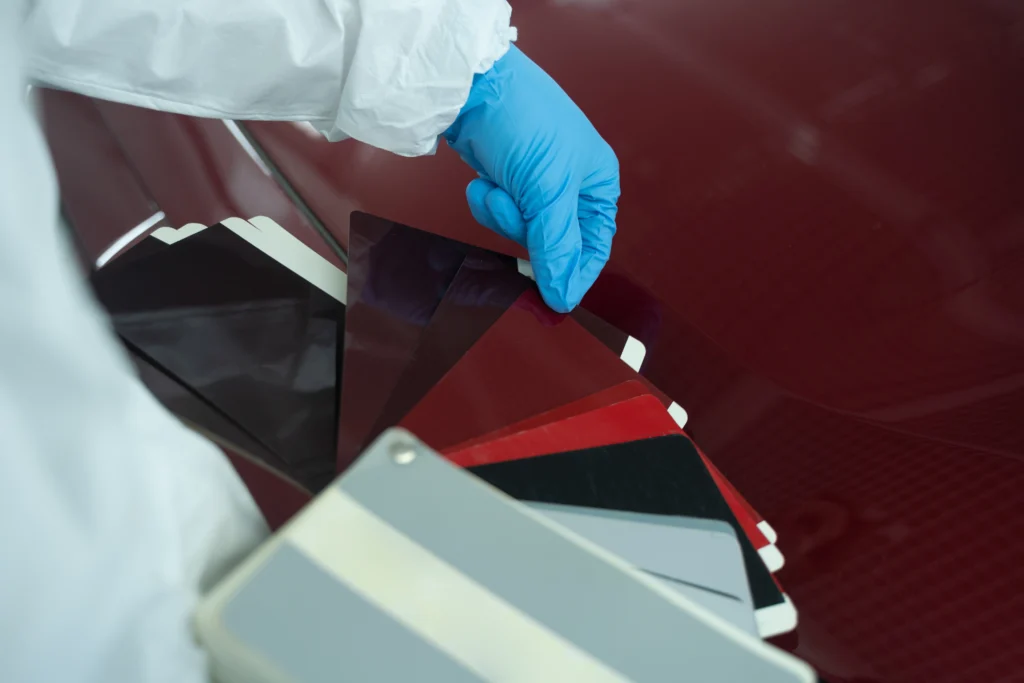Picking a car paint color can be exciting yet tricky. The right hue makes a big impact on how a vehicle looks and feels. It also affects resale value down the road.
A car’s paint color can boost or lower its value by hundreds or even thousands of dollars. Light neutral shades like white, gray, and silver tend to hold value best. But bold colors can make a car stand out.
Color matching is key when touching up paint or repainting parts of a car. Getting an exact match keeps the finish looking smooth and even. Many shops use computer color matching to nail the right shade.
Understanding Paint Basics
Car paint is more than just color. It protects the vehicle and affects its look. The right paint choice depends on many factors.
Types of Car Paint
Urethane paint is common on modern cars. It dries fast and resists fading. Acrylic paint costs less but doesn’t last as long. Some luxury cars use ceramic paint. It’s very tough but expensive.
Water-based paints are gaining popularity. They’re better for the environment. Metallic paints have tiny metal flakes. These create a sparkly look in sunlight.
Solid paints are one color all over. They’re easy to touch up if scratched.
Factors Affecting Durability
UV rays from the sun can fade car paint over time. Darker colors may fade faster than lighter ones. Salt on winter roads can damage paint and cause rust.
Regular washing helps protect paint. Waxing creates a barrier against the elements. Garage storage shields cars from sun and weather damage.
Some car makes and models use better paint than others. Higher-end vehicles often have more durable finishes.
Color Matching Technology
Computer color matching has improved paint repairs. Shops can now match original colors very closely. This works even for older or custom colors.
Spectrophotometers measure exact color shades. They help create precise paint formulas. Some body shops use paint chips to match colors by eye.
New cars come with a color code. This makes touch-ups easier. DIY kits are available for small repairs. But they may not match as well as professional work.
Considerations for Color Selection
Picking a car paint color involves more than personal preference. It can affect the vehicle’s value, your emotions, and how trendy it appears.
Influence of Color on Value
Car color impacts resale value. White, black, and silver tend to hold value better. These neutral shades appeal to a wide range of buyers. Red can be hit or miss – some love it, others don’t.
Rare colors may fetch higher prices for certain models. But they can also limit the pool of interested buyers. Think carefully before choosing an unusual hue.
Popular paint colors often sell faster. This can be helpful if you plan to trade in your car soon.
Emotional Impact of Colors
Colors can affect mood and perception. Red cars may feel sporty and exciting. Blue might seem calm and trustworthy. Black can look elegant and powerful.
Think about how you want to feel in your car. Also consider the image you want to project. A bright yellow car will turn heads, while gray blends in.
Some colors may even impact safety. Lighter shades like white are easier to see on the road.
Trends and Popularity
Car color trends change over time. What’s hot today might look dated in a few years. Silver and gray have been popular for a while. But earth tones are making a comeback.
Automakers release new colors each year. These often reflect broader design trends. Matte finishes and bold metallics are gaining fans.
Classic colors like black and white never go out of style. They’re safe choices if you’re unsure about current trends. But don’t be afraid to pick a color you truly love, regardless of what’s popular.
Practical Tips for Selecting Car Paint
Choosing the right paint color for your car involves more than just personal taste. It requires thinking about your car’s model, the environment it will be in, and any legal rules that might apply.
Matching Paint with Car Model
Some colors look better on certain car models. Sports cars often shine in bold reds or sleek blacks. Family sedans may look best in more subtle shades like silver or blue. Think about your car’s shape and size when picking a color.
For older cars, check the VIN to find the original paint code. This can help if you want to restore the car to its factory color.
Resale value is also important. Neutral colors like white, black, and gray tend to sell better than bright or unusual colors.
Considering Environmental Factors
Where you live affects your paint choice. In sunny areas, light colors reflect heat and keep the car cooler. Dark colors absorb more heat, which can be good in colder places.
Cars in coastal areas face salt air, which can damage paint. In these places, choose a paint with extra protection against corrosion.
City dwellers might prefer colors that don’t show dirt as easily. Gray and silver are good at hiding dust and grime between washes.
Navigating Legal and Brand Guidelines
Some places have rules about car colors. For example, certain emergency vehicle colors might be off-limits for regular cars.
If you’re repainting a brand-name car, be aware of trademark issues. Using exact brand colors or logos without permission could cause legal problems.
For custom paint jobs, make sure you’re not copying someone else’s design. This could violate copyright laws.
Check your local laws about reflective or very bright paints. Some places have rules about how shiny or distracting a car’s paint can be.
Application and Maintenance of Car Paint
Car paint needs proper application and care to look its best. The right methods and tools make a big difference in the final result and how long it lasts.
Choosing the Right Application Method
Spray painting is the most common way to apply car paint. It gives an even finish. Many auto body shops use special spray guns. These guns create a fine mist of paint.
For small touch-ups, brush painting can work. But it may leave brush marks. Rollers are another option for larger areas. They’re cheaper than spray guns.
The car’s surface must be clean and smooth before painting. Sanding helps the paint stick better. Primer is also important. It creates a good base for the paint.
Maintaining the Color’s Integrity
Regular washing keeps car paint looking fresh. Use car soap, not dish soap. Dish soap can strip the paint’s protective layer.
Waxing protects the paint from sun and rain damage. Apply wax every few months. For extra shine, use a polish before waxing.
Park in shade when possible. Sun fades paint over time. Bird droppings and tree sap can also harm paint. Clean them off quickly.
Fix chips and scratches right away. They can lead to rust if left alone. Touch-up paint is good for small spots. Bigger damage may need pro help.


